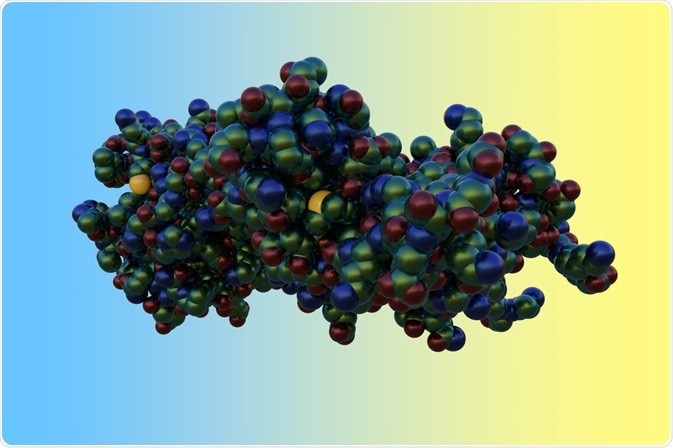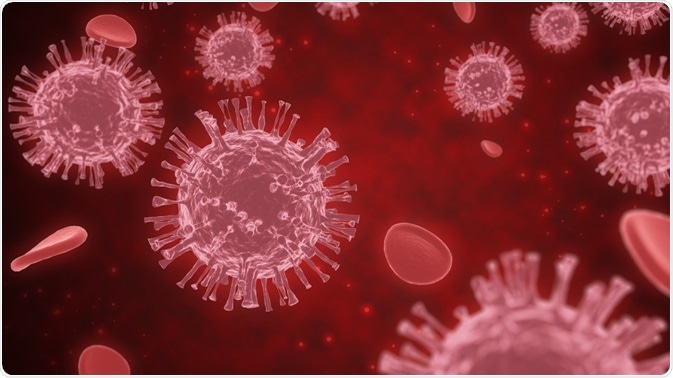A pathogen’s ability to infect or damage its host tissues are determined by the virulence factors. These are often molecules synthesized by the bacteria or virus and encoded in their genome, but may also be acquired from the environment via transmissible genetic elements.

Image Credit: Maryna Olyak/Shutterstock.com
Examples of virulence factors
The virulence factors of bacteria and viruses can differ drastically, due to the obvious differences in their composition. A bacteria’s virulence factors can be based on, for example, the capsule and flagella, which would not apply to a virus. However, a virus’ virulence factors can depend on the proteins it co-opts the host cell to synthesize virulence factors.
Many bacterial capsules prevent the immune system, such as the macrophages and neutrophils, to detect the bacteria. The capsules’ ability to evade the immune system can let the bacteria go undetected unless antibodies are developed to match the capsular antigens.
Movement and attachment are also important considerations for bacterial virulence. The flagella, which aids in movement, can help bacteria spread. The flagellum is a key virulence factor in urinary tract infections because it helps the bacteria spread up the urethra. Pili are shorter filaments that aid in attachment. Greater ability to adhere to tissues improves the bacteria’s infectivity.
One of the more significant virulence factors of bacteria is exotoxins. When released by bacteria, exotoxins can interrupt and dysregulate important cellular processes. They can also aid in the bacterial proteins’ capacity to invade tissues. Similarly, viral virulence factors can consist of efficient replication and protein synthesis to increase virulence.
Virulence factors and treatments
Finding treatment options for pathogens is a constant struggle, especially in the age of antibiotic resistance. It is becoming increasingly common that virulence factors are identified at the molecular and genetic level, which opens up the possibility of targeting virulence factors as a form of treatment against pathogens.
Many antibiotics kill both pathogenic and commensal, not harmful, bacteria, which can lead to adverse side effects. Since commensal bacteria will not likely share a pathogenic bacteria’s virulence factors, drugs targeting virulence factors can theoretically prevent many of these deleterious effects. Similarly, infections caused by or related to biofilms are not always treatable by antibiotics and could instead be treated by virulence factor-related drugs.
Many virulence factors focus on the evasion of the host immune system. Some of these, such as meningococcal sepsis and some pneumonia, can debilitate an otherwise healthy patient. While the principle of these virulence mechanisms as therapeutic targets is sound, there is not much experimental evidence of the merit of this approach.
Less specific drugs are not the only way that virulence factors can be targeted. Some virulence factors are believed to comprised of, or heavily dependent on, the nutritional status of the host both before and during infection.
Therefore, proper nutritional care of patients can prevent virulence factors from being as successful as they would otherwise be. This is especially true for diseases that commonly have a lack of appetite as a symptom, such as COVID-19.

Image Credit: tigerder/Shutterstock.com
Virulence factors and COVID-19
COVID-19 has had huge impacts all over the world, partly due to its infectiousness. This high level of infectiousness is enabled by its virulence factors, which are being intensely studied. One of the more famous ones is the health of the host – older men and people with immune dysfunctions appear to be more susceptible to worse effects of COVID-19.
Another potential virulence factor of COVID-19 is the nutritional status of the host. This is not uncommon among viruses since the immune defenses that need to be mounted against viral infections can be energetically expensive. In many coronaviruses, the intestine is a common location for viral proliferation. If this is the case for COVID-19, nutritional status can be even more important as a virulence factor.
While the evidence so far is rare, there is an observation that nutritional status can affect the outcome of COVID-19 infection. Of the deceased, 3% had malnutrition. This is comparable to 0% of survivors. This can function through a lack of vitamins, such as vitamins A and D, which are critical for innate and adaptive immune responses.
Another postulated virulence factor of COVID-19 is related to T cells. In many patients with COVID-19, there is a decrease in CD4 T cells following infection as conditions worsen. This is believed to be a critical virulence factor, but how this mechanism works is not well understood yet. Some postulate this is linked to nutrition, as some evidence exists showing reduced iron and zinc lead to decreases in CD4 T cells in mice.
Sources
- Pathwaymedicine.org. 2020. Bacterial Virulence Factors. [online] Available at: <http://www.pathwaymedicine.org/bacterial-virulence-factors>.
- Cross, A., 2008. What is a virulence factor? Critical Care, 12(6), p. 197.
- Webb, S., and Kahler, C., 2008. Bench-to-bedside review: Bacterial virulence and subversion of host defenses. Critical Care, 12(6), p. 234.
- Briguglio, M., Pregliasco, F., Lombardi, G., Perazzo, P. and Banfi, G., 2020. The Malnutritional Status of the Host as a Virulence Factor for New Coronavirus SARS-CoV-2. Frontiers in Medicine, 7.
Further Reading
- All Coronavirus Disease COVID-19 Content
- What Mutations of SARS-CoV-2 are Causing Concern?
- What is the Clinical Impact of COVID-19 on Cancer Patients?
- Can Pets Get COVID-19?
- An Overview of the SARS-CoV-2 Vaccines
Last Updated: Jul 16, 2020

Written by
Sara Ryding
Sara is a passionate life sciences writer who specializes in zoology and ornithology. She is currently completing a Ph.D. at Deakin University in Australia which focuses on how the beaks of birds change with global warming.
Source: Read Full Article
